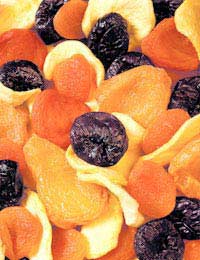
Drying fruit and tomatoes is a great solution to a glut. If you grow your own, it’s a good way to enjoy the fruits of your labour for a longer season. The dried fruits and tomatoes can be used in all kinds of baking and savoury recipes – use them wherever freeze-dried is specified. Look out for cheap cherry tomatoes, apricots and raspberries when they arrive at the grocer’s or farmer’s market. Then bring home a bagful and try out our home-drying advice and recipes!
Drying Tomatoes and Fruit at Home
If you don’t have a professional dehydrator, you can still dry fruit using your home oven. Sun drying is a technique used in hotter climates than ours. Solar dryers are used in Africa; these are similar to our cold frames, with racks suitable for fruit or vegetables, and glass coverings to protect the fruits from insects and animals. As you’re unlikely to get such long, hot days in the British summer, oven-drying is the best option to use in this country. It’s quick enough to ensure that the fruit dries thoroughly before developing mould (a common problem with air-drying methods).
Drying Raspberries and Strawberries
You can dry berries in the same way as tomatoes. Wash the berries thoroughly, then set the oven temperature at its lowest, spread the berries on baking trays, and leave for a few hours until dry. Large strawberries should be thinly sliced before being oven-dried. Raspberries take a long time to dry in this way; a better way may be to puree the fruits, sieve to remove the seeds, then spread thinly over your tray, and continue with the drying process. Break up the resulting ‘leather’ to make raspberry chips – use these as an alternative to freeze-dried raspberries in cereal and cookie recipes.
Drying Plums and Apricots
Plums and apricots will take around 6-8 hours to dry at a temperature of 80 degrees C (or your oven’s lowest setting, if lower). Wash, halve and stone your fruit, then dip it into a bowl of fresh lemon juice before spreading out on the baking tray. You can also dry apples in this way, slicing before dipping. Use the dried fruits in muffin and granola recipes – or as a quick snack at lunch
Drying Tomatoes
Drying your homegrown tomatoes is a great way of storing them for a few extra weeks. You can choose whether to semi-dry or fully dry your tomatoes. Cherry tomatoes work especially well with this treatment. Halve every tomato and spread the halves on a baking sheet. Set your oven to its lowest temperature and put in the tomatoes. Check after two hours to see if they’re dried to your liking. Storing your home-dried tomatoes is easy. Pack them straight into a sterilised jar, then pour in enough olive oil to fully cover the tomatoes. Seal and keep in the fridge. You can use these tomatoes in any recipes that call for sun dried tomatoes (try stirring them through pasta with rocket pesto) or offer them on a plate as part of a mezze spread.
